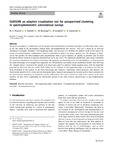| dc.contributor.author | Álvarez, M. A. | |
| dc.contributor.author | Dafonte, Carlos | |
| dc.contributor.author | Manteiga, Minia | |
| dc.contributor.author | Garabato, D. | |
| dc.contributor.author | Santoveña, Raúl | |
| dc.date.accessioned | 2022-03-23T18:26:25Z | |
| dc.date.available | 2022-03-23T18:26:25Z | |
| dc.date.issued | 2022 | |
| dc.identifier.citation | Álvarez, M.A., Dafonte, C., Manteiga, M. et al. GUASOM: an adaptive visualization tool for unsupervised clustering in spectrophotometric astronomical surveys. Neural Comput & Applic 34, 1993–2006 (2022). https://doi.org/10.1007/s00521-021-06510-9 | es_ES |
| dc.identifier.issn | 1433-3058 | |
| dc.identifier.uri | http://hdl.handle.net/2183/30195 | |
| dc.description | Financiado para publicación en acceso aberto: Universidade da Coruña/CISUG | es_ES |
| dc.description.abstract | [Abstract] We present an adaptive visualization tool for unsupervised classification of astronomical objects in a Big Data context such as the one found in the increasingly popular large spectrophotometric sky surveys. This tool is based on an artificial intelligence technique, Kohonen’s self-organizing maps, and our goal is to facilitate the analysis work of the experts by means of oriented domain visualizations, which is impossible to achieve by using a generic tool. We designed a client-server that handles the data treatment and computational tasks to give responses as quickly as possible, and we used JavaScript Object Notation to pack the data between server and client. We optimized, parallelized, and evenly distributed the necessary calculations in a cluster of machines. By applying our clustering tool to several databases, we demonstrated the main advantages of an unsupervised approach: the classification is not based on pre-established models, thus allowing the “natural classes” present in the sample to be discovered, and it is suited to isolate atypical cases, with the important potential for discovery that this entails. Gaia Utility for the Analysis of self-organizing maps is an analysis tool that has been developed in the context of the Data Processing and Analysis Consortium, which processes and analyzes the observations made by ESA’s Gaia satellite (European Space Agency) and prepares the mission archive that is presented to the international community in sequential periodic publications. Our tool is useful not only in the context of the Gaia mission, but also allows segmenting the information present in any other massive spectroscopic or spectrophotometric database. | es_ES |
| dc.description.sponsorship | This work made use of the infrastructures acquired with grants provided by the State Research Agency (AEI) of the Spanish Government and the European Regional Development Fund (FEDER), RTI2018-095076-B-C22. We acknowledge support from CIGUS-CITIC, funded by Xunta de Galicia and the European Union (FEDER Galicia 2014-2020 Program) through grant ED431G 2019/01 and research consolidation grant ED431B 2021/36. This work has made use of data from the European Space Agency (ESA) mission Gaia (https://www.cosmos.esa.int/gaia), processed by the Gaia Data Processing and Analysis Consortium (DPAC), https://www.cosmos.esa.int/web/gaia/dpac/consortium). Funding for the DPAC has been provided by national institutions, in particular the institutions participating in the Gaia Multilateral Agreement. Funding for the Sloan Digital Sky Survey IV has been provided by the Alfred P. Sloan Foundation, the U.S. Department of Energy Office of Science, and the Participating Institutions. SDSS-IV acknowledges support and resources from the Center for High Performance Computing at the University of Utah. The SDSS website is www.sdss.org. SDSS-IV is managed by the Astrophysical Research Consortium for the Participating Institutions of the SDSS Collaboration. We also want to acknowledge Alhambra survey funded by the Spanish Goverment under Grant AYA2006-14056. Open Access funding provided thanks to the Universidade da Coruña/CISUG agreement with Springer Nature | es_ES |
| dc.description.sponsorship | Xunta de Galicia; ED431G 2019/01 | es_ES |
| dc.description.sponsorship | Xunta de Galicia; ED431B 2021/36 | es_ES |
| dc.language.iso | eng | es_ES |
| dc.publisher | Springer | es_ES |
| dc.relation | info:eu-repo/grantAgreement/AEI/Plan Estatal de Investigación Científica y Técnica y de Innovación 2017-2020/RTI2018-095076-B-C22/ES/MINERIA DE DATOS DE GAIA PARA ESTUDIAR LA VIA LACTEA II/ | |
| dc.relation | info:eu-repo/grantAgreement/MEC/Plan Nacional de I+D+i 2004-2007/AYA2006-14056/ES/PROYECTO ALHAMBRA. ESTUDIO SISTEMATICO DE LA EVOLUCION COSMICA/ | |
| dc.relation.uri | https://doi.org/10.1007/s00521-021-06510-9 | es_ES |
| dc.rights | Atribución 4.0 Internacional | es_ES |
| dc.rights.uri | http://creativecommons.org/licenses/by/4.0/ | * |
| dc.subject | Big data astronomy | es_ES |
| dc.subject | Self-organizing maps visualization | es_ES |
| dc.subject | Computational astrophysics | es_ES |
| dc.subject | Artificial neural networks | es_ES |
| dc.subject | Astronomical surveys | es_ES |
| dc.title | GUASOM: An Adaptive Visualization Tool for Unsupervised Clustering in Spectrophotometric Astronomical Surveys | es_ES |
| dc.type | info:eu-repo/semantics/article | es_ES |
| dc.rights.access | info:eu-repo/semantics/openAccess | es_ES |
| UDC.journalTitle | Neural Computing and Applications | es_ES |
| UDC.volume | 34 | es_ES |
| UDC.startPage | 1993 | es_ES |
| UDC.endPage | 2006 | es_ES |
| dc.identifier.doi | 10.1007/s00521-021-06510-9 | |






